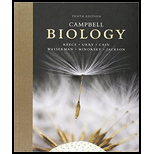
Concept explainers
To analyze: The allosteric regulation of the enzyme phosphofructokinase by ATP and related molecules during glycolysis and to find whether the ATP that is considered to be allosteric regulator inhibits or stimulates the activity of the enzyme phosphofructokinase.
Concept introduction:
The enzyme phosphofructokinase plays its role in the most important regulatory step (energy investment step) of glycolysis. It converts fructose-6 phosphate to fructose-1,6 bisphosphate. The regulation of phosphofructokinase is said to be allosteric due to the binding of an effector molecule other than the enzyme's active site. Adenosine triphosphate (ATP) is known as the allosteric regulator for this enzyme in this step of glycolysis.
Want to see the full answer?
Check out a sample textbook solution
Chapter 9 Solutions
Campbell Biology - With Access (Custom)
- Q36. The picture below shows a preparation of isolated thylakoid membranes suspended in a buffer at pH 8. The preparation is in complete darkness. Which of the following is required in order for the thylakoids to generate ATP? A. Addition of ADP and phosphate to the buffer. B. Incubation in the light plus ADP and phosphate. C. Incubation in the light plus addition of ADP, phosphate and NADP+. D. Isolated thylakoid membranes are not able to synthesize ATP.arrow_forwardPls help ASAP, thanks! "Yeast yields ethanol from pyruvate in two steps. Step one requires the co-enzyme __ , which is necessary for the substrate to undergo oxidative decarboxylation."arrow_forwardQ) Start with a photon of sunlight and a carbon atom in a molecule of carbon dioxide in the atmosphere: model/diagram their pathway from that starting point to their final destination as a glucose molecule that is used for energy in a cell in the plant root. Following your diagram/model, provide a written explanation for what your diagram/model depicts. Make sure both your model and explanation are clear, concise, and have the appropriate level of detail to clearly demonstrate you understand photosynthesis, cellular respiration, and the movement of mass and energy in plants.arrow_forward
- Give typed full explanation Diagram the path of electron flow from NADH to the final electron acceptor during oxidative phosphorylation in mitochondria. For each electron carrier, indicate whether only electrons or both electrons and protons, are accepted/donated by that carrier. B) What would happen to this electron flow and what are the resulting consequences if myxothiazol is added to actively respiring mitochondria using succinate as an electron donor? C) Would you predict ubiquinone reduction to ubiquinol would be more favored at acidic pH or alkaline pH? Why? And as a result, would you predict Complex I active site for this reaction is closer to the N side or P side of the mitochondria?arrow_forwardBioKemi!! Make a theoretical calculation of how many ATP molecule of acetyl-CoA to Carbon dioxide and water if the entire proton gradient across the mitochondrias inner membrane can be used for ATP production and when the ATP synthase has 15 c-subunits? All steps in the calculations must be reported Hand written solution otherwise down votearrow_forwardUsing Model 10.9, draw the structure of the substrates of the pentose phosphate pathway and write down the enzymes and coenzymes that are involved in the reactionarrow_forward
- Pls help ASAP, thank you! "Regulation of metabolic pathways most typically occurs at enzyme steps that are"arrow_forwardQ1: Define ATP in your own words. Q2: How is ATP involved in anabolism and catabolism? (Hint: Review Figure 5.3.) Q3: Arsenic disrupts ATP production. Why would this characteristic cause it to be a potent poison?arrow_forwardBiochemists spent decades looking for a "high energy intermediate" that linked the production of reducing equivalents from glycolysis and the TCA cycle to the production of ATP. They were unsuccessful until Peter Mitchell put aside that search and proposed a different mechanism known as the chemiosmotic theory. Describe the chemiosmotic theory as well as the experiment that proved it was correct.arrow_forward
- please draw1 10. Diagram in detail the oxidative phosphorylation stage of cellular respiration demonstrating how the bulk of the ATP is made during that stage. Accompanying your diagram should be a paragraph explaining the ATP production processarrow_forwardApply your understanding of the various components of the electron transport chain to evaluatehow the roles of ubiquinone and cytochrome c differ from those of the other components. Whatrole does NADH and FADH2 play in redox reactions?arrow_forwardQ40. Both Photosynthesis and respiration rely on electron transport. Although there are many differences, what do these electron transport chains have in common? In both, the electron donor (water in the case of photosynthesis, NADH in the case of respiration) is a strong reducing agent In both, the proteins which shuttle the electrons (Plastoquinone in photosynthesis, Ubiquinone in the case of respiration) are oxidized and reduced In both, electrons move spontaneously from high to low redox potential. In both, chemiosmosis results in the production of ATP A. 1,2 and 3 B. 1 and 3 C. 2 and 4 D. 4 only E. All of 1, 2, 3 and 4 are correctarrow_forward
 Biology (MindTap Course List)BiologyISBN:9781337392938Author:Eldra Solomon, Charles Martin, Diana W. Martin, Linda R. BergPublisher:Cengage Learning
Biology (MindTap Course List)BiologyISBN:9781337392938Author:Eldra Solomon, Charles Martin, Diana W. Martin, Linda R. BergPublisher:Cengage Learning
